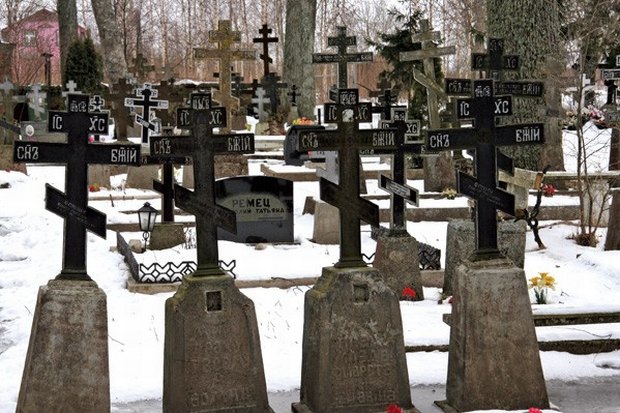
From Old Believer cemetery in Varnja. Photo: Odd Iglebaek
The Society of Old Believer Culture and Development in Estonia, www.starover.ee, represents a group of Russian 'Old Believers' (starovery), about 15000 people in all. The majority of whom live on the Estonian shore of Lake Peipus/Chudskoe. The Russian 'Old Believers' escaped from Russia to what is now Eastern Estonia in the late 17th century as they did not agree with the reform of the Russian Orthodox Church conducted by Patriarch Nikon. Since then their cultural heritage, churches, museums and local architecture have attracted both local and international tourists.
Another active organisation is the Setomaa Union of Local Authorities, www.setomaa.ee, representing the Seto people who live on the border with Russia. They speak the Seto language, which is a Southern-Estonian dialect, and have a distinct culture.
In Estonia there are 10 000 –13 000 Seto people. 3000 – 4000 live in the historical location of the Setomaa in the southern part of the Russian-Estonian border area. In Russia there are only about 100 Seto people left, since most have relocated to Estonia. Graveyards and other symbolically important places however remain situated on the Russian side of the border.
Established 1927, an NGO Fenno-Ugria, www.fennougria.ee, works to promote contacts between Estonians and other Finno – Ugric people living mostly in central and northern Russia. Fenno-Ugria functions as a coordinating establishment for cooperation and information exchange with the other Uralic (Finno-Ugrian and Samoyed) peoples. In total, there are more than 120 nationalities in Estonia represented by four cultural organisations, which are united in the Alliance of Nationalities of Estonia.
The above-mentioned cultural groups, Seto and Old-Believers, as well as a few others native Estonia cultural organisations joining Russians, Ukrainians, Belarusians, etc. are primarily descendants of "Russian – speakers" who moved to Estonia in 1950–1960s. They came from many different parts of the former Soviet Union. Mostly they re-settled to work in the large industrial machinery and chemistry enterprises built in Northeastern Estonia.
Today the multiple cultural societies in North-eastern Estonia are active in the promoting of their own culture and languages as well as in maintaining contact with their historical motherlands.
The most obvious examples of economic cross-border cooperation are the chambers of commerce and entrepreneurs. Cooperation is active between the predominantly Russian-speaking munici-palities of Narva and Kohtla – Järve and the municipalities of St. Petersurg, Ivangorod and Kingisepp on the Russian side. The only Euroregion, a union of border municipalities from Estonia, Latvia and Russia, is the Pskov–Livonia Euregio, which was established in 1996 with the support of the Swedish Union of Local Authorities.
The potential remains for the formation of a larger number of Euroregions in the Estonian–Russian border area. At present however local actors simply do not have sufficient resources to establish and sustain such cross-border cooperation efforts.
The large transboundary lake named Peipsi in Estonian and Chudskoe in Russian, one of the largest lakes in Europe, is located in the in the Baltic Sea basin. Environmental organisations thus have an important role to play in Estonian – Russian cross-border cooperation. Universities, NGOs, municipalities and environmental officials work hand-in-hand to promote environmentally sustainable development in the Lake Peipsi/Chudskoe Basin.
It should however be mentioned also, that on the Russian side, in the economically less developed oblast of Pskov, social orientation organisations are interested in cooperating with similar organisations in Estonia. However, differences in the national level approaches to support less protected groups of the population in Estonia and Russia, a weak knowledge of English needed to write cooperative projects and a lack of international project management experience are probably the main reasons for absence of such cooperation thus far.
By Gulnara Roll
- Better before
- In many ways it was better in Soviet-days, says Niina Baranina, Head of the Peipiääre rural municipality, a one thousand inhabitant rural community on the Estonian side of the Lake Peipsi.
- Most importantly fishing in the Lake was less regulated. We could fish all year round and there were no borders in the lake. After joining the EU we can only fish a few weeks every year, from 15 March to 5 May and 15 September to 15 October, she continues.
The head of the municipality explains that on the Russian side they are now allowed to fish seven months annually. - The result is of course that many of our fishermen have been forced to give up. In fact, before we had 160 but now only five.
- So yes, I do think the government should take initiatives to make it possible to fish on the whole aquatory of the lake. We should also remember that the fish migrate in the Peipsi independent of any borders.
The village of Varnja which is part of the Peipsiääre rural municipality has only 200 inhabitants. – Last year however three babies were born in the village. In Estonia all new mothers get 18 months full income-compensation, explains Raissa Poljakova, a worker at the local library and a representative of a local grassroots NGO "Varnja Family Society".
This NGO takes care of a small local museum: - It is a very important element in keeping the community alive. It provides us with a sense of belonging as well as a place to congregate.
It seems that many in the district are not too happy with Estonia's EU-membership. At the same time many people from the area travel to work abroad, particularly in the building industry. Finland, Ireland and Norway seem to be the most popular destinations:
- It is true that they bring income, but I guess it is fair to say that we are paying a price for this. Before we had development and a future, but now in fact our communities are at a virtual standstill in development terms, concludes Niina Baranina.
By Odd Iglebaek